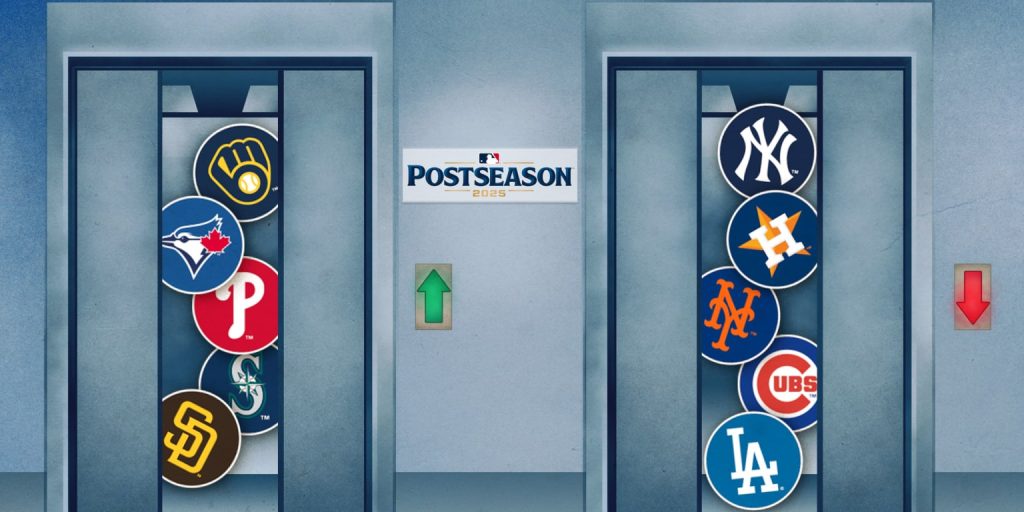The previous month has highlighted the rapid changes in baseball, even during the current season’s later stages.
Since the second half commenced on July 18—exactly one month ago—there have been significant changes in five of the six MLB division races.
All statistics mentioned, including odds, are as of Sunday.
Biggest riser: Blue Jays, +42.5 (37.2% to 79.7%)
Biggest faller: Yankees, -30.4 (45.5% to 15.1%)
Before the Break:
The Yankees dominated the AL East for much of the first three months, but the division dynamics began to change in late June as they faltered. The Blue Jays overtook the Yankees on July 3, finishing the first half with a two-game lead. However, Toronto’s +17 run differential raised questions about their viability as contenders, especially compared to the Yankees’ impressive +111.
Since the Break:
The Blue Jays have established themselves as the leading team in the division, holding the best record in the AL (18-11) since the All-Star break, driven by a lineup averaging over six runs per game. In contrast, the Yankees have merely held a .500 record (14-14), slipping further behind Toronto and even allowing the Red Sox to overtake them. After winning two of three against both the Cubs and the Rangers last week, the Blue Jays held a five-game lead over the Red Sox and a 5 1/2-game advantage over the Yankees as of Monday.
Biggest riser: Tigers, +1.0 (96.6% to 97.6%)
Biggest faller: Twins, -2.1 (2.1% to 0.0%)
Before the Break:
The Tigers were the stars of the first half, boasting the best record in MLB at 59-38 and sending six players to the All-Star Game, four of whom started for the AL. With no other AL Central teams performing above .500, Detroit began the second half with a solid 11 1/2 game lead in the division.
Since the Break:
After a shaky start post-break and a surge from the Guardians, Cleveland trimmed its deficit in the AL Central to five games by August 10. However, the Tigers never saw their division title odds drop below 91.5% and have begun extending their lead again, winning six of their last eight games. The Guardians, who were swept by the Braves last weekend, now sit 8 1/2 games behind.
Biggest riser: Mariners, +22.4 (23.3% to 45.7%)
Biggest faller: Astros, -20.2 (73.6% to 53.4%)
Before the Break:
The Astros, who started at 26-25, went on to win 29 out of 39 games, creating a substantial gap over the Mariners in the AL West. By the end of the first half, they had one of the best odds of securing the division title.
Since the Break:
With injuries continuing to plague them, including the recent loss of closer Josh Hader, the Astros have struggled with a 13-15 record post-break. The acquisition of Carlos Correa at the Trade Deadline has not alleviated their issues. Meanwhile, the Mariners, who strengthened their lineup with new additions, have performed well, boasting a 17-12 record since the break, significantly tightening the AL West race.
Biggest riser: Phillies, +22.2 (58.1% to 80.3%)
Biggest faller: Mets, -21.9 (41.6% to 19.7%)
Before the Break:
The Phillies had a narrow half-game lead over the Mets as they approached the All-Star break, with both teams trading the NL East lead throughout the first half.
Since the Break:
While the Mets regained the NL East lead during a seven-game winning streak in late July, the Phillies have surged ahead. Notably, even the relief pitchers each team acquired at the Trade Deadline have made a considerable impact—Jhoan Duran (0.00 ERA, five saves with Phillies) has outperformed Ryan Helsley (0-3, 7.11 ERA with Mets). The Phillies have gained 6 1/2 games on the Mets, who only managed a 4-14 record during the same period.
Biggest riser: Brewers, +61.2 (31.8% to 93.0%)
Biggest faller: Cubs, -57.1 (64.1% to 7.0%)
Before the Break:
The Cubs led the NL Central for most of the first half, while the Brewers were in fourth place, trailing by 10 games. However, Milwaukee managed to close the gap significantly by the All-Star break with an impressive 31-12 record in their last 43 games before the break.
Since the Break:
The Brewers have maintained their momentum after the All-Star break, achieving a remarkable 22-5 record that includes a franchise-record 14-game winning streak. In contrast, the Cubs have struggled, averaging just 3.78 runs per game since the break, falling behind Milwaukee by eight games in the NL Central.
Biggest riser: Padres, +13.2 (2.7% to 15.9%)
Biggest faller: Dodgers, -10.1 (94.2% to 84.1%)
Before the Break:
After a competitive mid-June, the Dodgers began to pull ahead, extending their lead to nine games by July 3. However, the Padres managed to narrow the gap to 5 1/2 games by the break.
Since the Break:
Fueled by a successful Trade Deadline, the Padres have continued to apply pressure on the Dodgers in the second half, even briefly taking the lead. Although the Dodgers reclaimed their division lead with a recent three-game sweep, FanGraphs still views them as heavy favorites, suggesting this race may go down to the wire.



